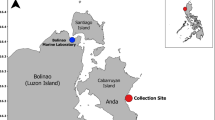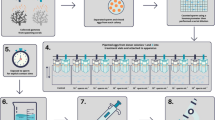Abstract
In order to determine competency of sexual reproduction and survival rate after fragmentation, the branching coral Acropora formosa was fragmented and fragments in three different sizes (ca. 5, 10 and 20 cm long) and three different stages of gametogenesis were transplanted on coral pavement. Their oocyte development and fecundity, as well as spawning were monitored for a 3-year period. The oocyte development was affected by both fragment size and by the developmental stage of oocytes when fragmented. In small fragments, the oocytes were resorbed while in large fragments they continued development. Oocytes in the early vitellogenic stage at the time of fragmentation were resorbed, whereas those in the late stage continued developing. Smaller fragments showed a lower survival rate and histological observations of their gonads revealed resorption of oocytes, suggesting that there was a trade-off of energy between reproduction and survival. Transplanted fragments often spawned one month earlier than the donor colonies in the first year, but spawning occurred in the same month as the donors or did not occur at all in the second year and none spawned in the third year. The risk of colony death may cause the fragments to re-allocate energy for sexual reproduction.





Similar content being viewed by others
References
Bruckner AW, Bruckner RJ (2001) Condition of restored Acropora palmata fragments off Mona Island, Puerto Rico, two years after the Fortuna Reefer ship grounding. Coral Reefs 20:235–243
Bruno JF (1998) Fragmentation in Madracis mirabilis (Duchassaing and Michelotti): how common is size-specific fragment survivorship in corals? J Exp Mar Biol Ecol 230(2):169–181
Bryant D, Burke L, McManus J, Spalding M (1998) Reefs at risk: a map-based indicator of threats to the world’s coral reefs. World Resources Institute, Washington, DC
Chornesky EA, Peters EC (1987) Sexual reproduction and colony growth in the scleractinian coral Porites astreoides. Biol Bull 172:161–177
Connell JH (1973) Population ecology of reef-building corals. In: Jones OA, Endean T (eds) Biology and geology of coral reefs. Academic, New York. pp 205–245
Contreras-Sanchez WM, Schreck CB, Fitzpatrick MS, Pereira CB (1998) Effects of stress on the reproductive performance of rainbow trout (Oncorhynchus mykiss). Biol Reprod 58:439–447
Custodio III HM, Yap HT (1997) Skeletal extension rates of Porites cylindrica and Porites (Synaraea) rus after transplantation to two depths. Coral Reefs 16:267–268
Fautin DG, Mariscal RN (1991) Cnidaria: Anthozoa. In: Harrison FW, Westfall JA (eds) Placozoa, Porifera, Cnidaria and Ctenophora. Microscopic anatomy of invertebrates, Book 2, Wiley-Liss, Inc., New York, pp 267–358
Fox HE, Mous PJ, Pet JS, Muljadi AH, Caldwell AR (2005) Experimental assessment of coral reef rehabilitation following blast fishing. Conserv Biol 19:98–107
Giekmann G, Keller MA, Temhumberg B (2004) The sweet tooth of adult parasitoid Cotesia rubecula; Ignoring hosts for nector? J Insect Behav 17:459–476
Hall VR, Hughes TP (1996) Reproductive strategies of modular organisms: comparative studies of reef-building corals. Ecology 77:950–963
Hayashibara T, Shimoike K, Kimura T, Hosaka S, Heyward A, Harrison P, Kudo K, Omori M (1993) Patterns of coral spawning at Akajima Island, Okinawa, Japan. Mar Ecol Prog Ser 101:253–262
Harriott VJ, Fisk DA (1988) Coral transplantation as a reef management option. In: Proceedings of the 6th international coral reef symposium, vol 2. Australia, pp 375–379
Highsmith RC (1982) Reproduction by fragmentation in corals. Mar Ecol Prog Ser 7:207–226
Hutton DMC, Smith VJ (1996) Antibacterial properties of isolated amoebocytes from the sea anemone Actinia equina. Biol Bull 191:441–451
Kojis BL, Quinn NJ (1985) Puberty in Goniastrea favulus: Age or size limited? In: Gabrie C, Salvat B (eds) Proceedings of the 5th international coral reef symposium, vol 4. Moorea, French Polynesia, Antenne Museum-EPHE, pp 289–293
Lewis JB (1991) Testing the coral fragment size-dependent survivorship hypothesis for the calcareous hydrozoan Millepora complanata. Mar Ecol Prog Ser 70:101–104
McManus JW, Reyes Jr RB, Nanola Jr CL (1997) Effect of some destructive fishing methods on coral cover and potential rates of recovery. Environ Manage 21:69–78
Nonaka M, Baird AH, Kamiki T, Yamamoto HH (2003) Reseeding the reefs of Okinawa with the larvae of captive-bred corals. Coral Reefs 22:34
Okubo N (2004) Transplantation of coral fragments: Acropora formosa. In: Omori M, Fujiwara S (eds) Manual for restoration and remediation of coral reefs, Nature Conservation Bureau, Ministry of the Environment, Japan, pp 62–67
Okubo N, Omori M (2001) The review of coral transplantation around the world in (Japanese with English abstract). Galaxea 3:31–40
Okubo N, Taniguchi H, Motokawa T (2005) Successful methods for transplanting fragments of Acropora formosa and Acropora hyacinthus. Coral Reefs 24:333–342
Omori M (2005) Success of mass culture of Acropora corals from egg to colony in open water. Coral Reefs 24:563
Rinkevich B (2005) Conservation of coral reefs through active restoration measures: recent approaches and last decade progress. Environ Sci Technol 39(12):4333–4342
Rodgers KS, Cox EF (2003) The effects of trampling on Hawaiian corals along a gradient of human use. Biol Conser 112:383–389
Schreck CB, Contreras-Sanchez W, Fitzpatrick MS (2001) Effects of stress on fish reproduction, gamete quality, and progeny. Aquaculture 197:3–24
Sebens KP (1982) Limits to indeterminate growth: an optimal size model applied to passive suspension feeders. Ecology 63:209–222
Smith CC, Fretwell SD (1974) The optimal balance between size and number of offspring. Am Nat 108:499–506
Smith LD, Hughes TP (1999) An experimental assessment of survival, re-attachment and fecundity of coral fragments. J Exp Mar Biol Ecol 235:147–164
Wilkinson CR (2002) Global and local threats to coral reef functioning and existence: review and predictions. Mar Freshw Res 50:867–878
Van Veghel MLJ, Bak RPM (1994) Reproductive characteristics of the polymorphic Caribbean reef building coral Montastrea annularis. III. Reproduction in damaged and regenerating colonies. Mar Ecol Prog Ser 109:229–233
Yap H. T. (2004) Differential survival of coral explants on various substrates under elevated water temperatures. Mar Pollut Bull 49:306–312
Zakai D, Levy O, Chadwick-Furman NE (2000) Experimental fragmentation reduces sexual reproductive output by the reef-building coral Pocillopora damicornis. Coral Reefs 19:185–188
Acknowledgments
We are grateful to K. Shimoike, S. Hosaka and the staff members of Akajima Marine Science Laboratory for their kind help, T. Kokita for assisting statistical analysis.
Author information
Authors and Affiliations
Corresponding author
Additional information
Communicated by S. Nishida, Tokyo.
Rights and permissions
About this article
Cite this article
Okubo, N., Motokawa, T. & Omori, M. When fragmented coral spawn? Effect of size and timing on survivorship and fecundity of fragmentation in Acropora formosa . Mar Biol 151, 353–363 (2007). https://doi.org/10.1007/s00227-006-0490-2
Received:
Accepted:
Published:
Issue Date:
DOI: https://doi.org/10.1007/s00227-006-0490-2




